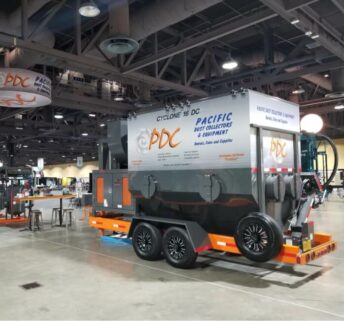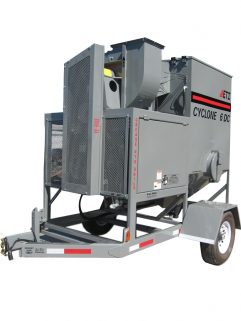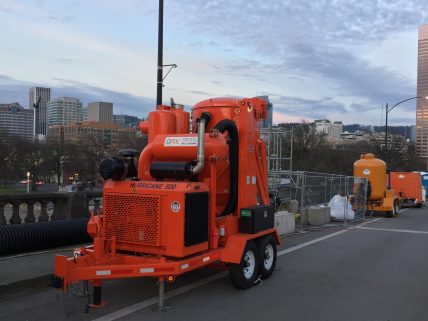Combustible dust clouds can fuel a flash fire or explosion when dispersed in a dust cloud. As a result, workers in many industries who handle combustible solids may experience combustible dust incidents that cause destruction, injuries, and even deaths. To control combustible dust incidents, dust collection is essential. However, choosing the right type of dust collection solution is important when you think of setting up a new system or considering installing additional elements to comply with NFPA and OSHA standards. You have to consider several factors to select the appropriate dust collection system for yourself. The first step is determining whether you need wet or dry dust collection. Typically, wet and dry dust collection makes use of different technologies and has differences in application. This makes it easier for them to collect a specific type of dust.
To collect dry dust, you must use dry media dust collectors. Wet dust collectors or wet scrubbers collect wet dust. These are the two primary dust collection methods in the industry. Apart from these, there are many different subtypes in the market.
Collection of Dry Dust
According to the NFPA, dry dust collectors are appropriate for collecting combustible dust in the surroundings. Some examples are media collectors or cyclones. For instance, dust passes through an inlet in air separators, then forced through a filter media with air. The dust will subsequently get dislodged from the filters into a bag, which will then go to the storage compartment.
Generally, whether the dry dust collection is efficient depends on the filter as well as the filter media, the size of the particulate matter, air pressure, and the type of combustible dust in the environment.
Wet Dust Collectors
Wet dust collectors are also known as wet scrubbers. They include cyclonic, venturi, or centrifugal scrubbers. These scrubbers use air pressure and water to remove dust from the air. Scrubbers will first drive dust through water spray or water stream. The dust will then end up at the bottom of the tank. Gravity separates the dust, and the dust will eventually fall into a storage container. In a cyclonic system, water flow drives the dust to the bottom collector. Then clean the collector once the dust settles at the bottom. Wet dust collection is generally very efficient and can capture very small particles.
Pacific Dust Collector & Equipment Can Help with Your Dust Collection Needs
Are you trying to find a dust collector but are unsure what to get? Here at Pacific Dust Collector & Equipment, our friendly team will be able to advise you on the type of dust collector that best suit your needs. We have a variety of dust collectors for you to choose from, and you will find what you need. So feel free to contact us to learn more about how we can help you with your wet and dry dust collection today!
In order to control combustible dust, dust collection is essential. However, when you are thinking of setting a new system or considering the installation of additional elements in order to comply with NFPA and OSHA standards, choosing the right type of dust collection solution is important. There are a number of factors you have to consider to select the appropriate dust collection system for yourself. The first step is determining whether you need wet or dry dust collection. Typically, wet and dry dust collection make use of different technologies and have differences in application. This makes it easier for them to collect a certain type of dust.
To collect dry dust, dry media dust collectors are typically used. They are also known as air separators. Wet dust collectors or wet scrubbers are used to collect wet dust. These are the primary dust collectors in the industry. Apart from these, there are many different subtypes in the market.
Collection of Dry Dust
According to the NFPA, dry dust collectors are appropriate to collect combustible dust in the surroundings. Some examples are media collectors or cyclones. In air separators, dust is collected through an inlet where air is forced through a filter media. The dust will subsequently get dislodged from the filters into a bag, where it will then go to the storage compartment. This storage compartment needs to be emptied regularly.
Generally, whether the dry dust collection is efficient or not is dependent on the filter as well as the filter media, the size of the particulate matter, air pressure and type of combustible dust that exists in the environment.
Wet Dust Collectors
Wet dust collectors are also known as wet scrubbers. They include cyclonic, venturi, or centrifugal scrubbers. These scrubbers use a mix of air pressure and water in order to remove dust from the air. Scrubbers will first drive dust through water spray or water stream. The dust will then end up at the bottom of the tank. Gravity separates the dust, and the dust will eventually fall into a storage container. If a cyclonic system is used, dust will be driven to the bottom through water flow. The dust will settle at the bottom, and the scrubber will need to be cleaned. Wet dust collection is generally very efficient and is able to capture particles that are very small.
Pacific Dust Collector & Equipment Can Help with Your Dust Collection Needs
Are you trying to find a dust collector but are unsure what to get? Here at Pacific Dust Collector & Equipment, our friendly team will be able to advise you on the type of dust collector you should get and recommend you one based on your needs. We have a variety of dust collectors for you to choose from, and you will definitely be able to find what you need for dust collection with us. Feel free to contact us to find out more about how we can help you with your wet and dry dust collection today!



